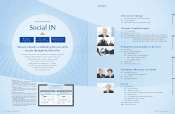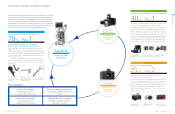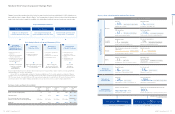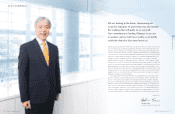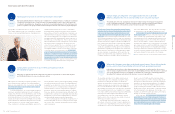Olympus 2015 Annual Report Download - page 13
Download and view the complete annual report
Please find page 13 of the 2015 Olympus annual report below. You can navigate through the pages in the report by either clicking on the pages listed below, or by using the keyword search tool below to find specific information within the annual report.
Nobody expects Olympus to release information that would di-
minish its competitiveness, but it would nice to have some sort
of basis on which to gauge the Company’s growth potential. If,
for example, you were to provide quantitative information on
how THUNDERBEAT should be viewed, this would be enough
of a hint for investors to work with.
Owaki: In evaluating Olympus, I believe that the Company has
advanced beyond the stage in which it should be concerned
merely with survival. The focus now needs to be on beating
out the competition. As well, while it is true that Olympus has
regained some degree of trust, a number of issues of varying
degrees have been surfacing. This situation is making inves-
tors anxious. For example, we have learned that the Medical
Business was subject to inspections by the U.S. Department
of Justice. This might cause one to worry that Olympus may
need to reform its business model. For this reason, I think
it is important for the Company to strengthen its compliance
systems in order to prevent such non-business occurrences
from lowering its reputation. This is a crucial task for competing
medical equipment manufacturers as well, but it is especially
important for Olympus.
Sasa: I agree completely. We must look to the future, and
advance our business based on more rigorous standards.
Moreover, we need to address future issues before they occur
to alleviate concerns for the future, give us a clear view of where
we are headed, and ensure that there are no more issues to
be uncovered, no matter how deeply someone may look.
Thenew management team is treating this matter with the
utmost seriousness. When the inspection of our U.S. operations
was initiated in 2011, we instituted a massive restructuring of
organizations in North America with the aim of preventing the
recurrence of such issues, and a substantial improvement has
already been witnessed. For example, we have established a
medical affairs division to function as an independent third
party with regard to the provision of donations and subsidies.
We have thereby installed controls to ensure the transparency
of these activities, and to weigh the pros and cons and thereby
determine appropriateness. The Company also implemented
massive reforms in other areas, including practicing strict man-
agement of demo products and the substitutes provided when
purchased products are undergoing repairs, thoroughly enforcing
regulations through regular in-house training, and stepping up
third-party monitoring and internal audits. Moreover, we are fully
aware of the fact that strengthening compliance systems and
managing risks is something that must be done not only in the
United States but on a global scale.
Owaki: What are your thoughts on the empowerment of
female employees? I understand that one of the Company’s
outside directors is a woman. However, just the one seems
rather low for a company that claims to care for people’s phys-
ical and mental health.
Sasa: Looking at the Olympus Group as a whole, there are
countless women working throughout our organization, partic-
ularly in Europe and the United States, and female employees
hold many high-ranking positions and represent a large portion
of our overall staff. In Japan, however, the situation is a bit dif-
ferent, and your criticism is quite valid. Olympus’ operations
have long been focused on manufacturing and development,
and we have a history of having limited access to new hires. Of
course, this is a situation that requires improvement. Olympus
is not closed off to women.
Discussing Olympus’ Ideal Form
Future Areas of Focus and Medium- to Long-Term Vision for Olympus
Sasa: In fiscal 2016, we will formulate the next corporate stra-
tegic plan. At the moment, discussions are proceeding within
the Company to determine what exactly the essence of
Olympus is and what constitutes our corporate genes.
Olympus’ technologies are No. 1, and we stand un-
matched on this front. Being able to say this with confidence
isour greatest strength. It is therefore crucial that we position
customers capable of understanding and appreciating our
technological prowess as our main targets. If not, we run the
risk of being judged based on overall competitiveness or finan-
cial capabilities, and we cannot beat the massive companies
seen in Europe and the United States with this respect. In this
manner, Olympus will not attempt to compete with these compa-
nies in the areas in which they excel. Rather, we will accurately
respond to the needs of specialists in niche markets, and
endeavor to become the leader in this area. This approach
will be adopted in all businesses. In the Medical Business,
for example, if a customer cannot understand the benefits and
superior performance of THUNDERBEAT, they will no doubt
purchase a less expensive product. For this reason, cultivating
this type of understanding among customers is crucial. In
theImaging Business as well, I believe that Olympus’ target
demographic is specialists as opposed to the broad general
consumer market. Gone are the days in which effective com-
mercials were enough to guarantee sales. In this manner, we
have analyzed the Company’s business, and formulated an
idea of the type of customer we should cater to as we develop
our operations.
In the Medical Business, we judged that our greatest defi-
ciency was sales capabilities, and thus determined that this
was the area in which we should first devote investments.
However, the full benefits of sales investments do not appear
immediately. Realizing this, our plan was to first invest in
strengthening our sales forces, and then to take advantage
ofthese investments when we launch our next new product.
This has been a focus for the past two years. Looking ahead,
we can expect a certain degree of cash to be generated when
werelease the technologies we have been developing or the
products we have been planning. At this point, we should be
able to invest in other areas.
In formulating the next corporate strategic plan, we will
determine the best use for all of the Company’s resources,
including those currently associated with the problematic
Imaging Business. With the strong conviction to realize further
growth, we will turn our eyes to the future of Olympus.
Nakanomyo: After hearing this explanation, I think probably
80% of people would nod in agreement. While I would gener-
ally place myself among this 80%, you must also consider the
responses of the remaining 20%. Several of Olympus’ prod-
ucts have established solid market positions, and these will
likely retain their differentiated competitive edge for at least the
next 3–5 years. I believe that your talk of strengthening sales
forces presumes this fact, and most people will understand
this. However, a common opposing opinion might be that,
from a technological perspective, you have to consider China,
which is gradually catching up with rest of the world in terms
of technologies. Meanwhile, at the other end of the spectrum,
we see a shift toward radically different imaging technologies,
namely 3D and 4K imaging. Given these two threats, are you
not a bit concerned?
Sasa: Quite frankly, I see little need for concern. We have care-
fully examined nearly all conceivable risks, and the technology
trends that are expected to occur in the market, and the new
products that will likely appear were not viewed as significant
threats affecting Olympus’ playing field. This judgment was
made after thorough evaluation of how the Company would be
impacted if these trends come to pass as well as thelikelihood
of their passing.
Yoshihara: Mr. Nakanomyo raises a point that I have found
concerning as well. When visiting a European investor recently,
it was brought to my attention that companies releasing dis-
posable endoscopes are on the rise. A decade ago, I suspect
that these companies would not have received much attention.
Today, however, amidst the aging of populations in Europe, the
United States, and Japan, and the resulting government move-
ments to limit medical expenses, the trend toward choosing
more affordable equipment over higher-priced, high-quality
equipment can be seen in developed countries as well. The
endoscope field is relatively resilient to such price sensitivity,
and it may therefore be one of the last bulwarks against this
trend. However, this trend has already begun to impact certain
examination apparatuses. Olympus may remain safe for the
next three years or so, but looking 5–10 years down the road
it is possible that the Company may need to address this
threat as well. With this perspective, I must stand with the
remaining 20% that Mr. Nakanomyo spoke of, and say that
I am concerned.
Sasa: The medical industry will not change to any great extent
in just five years. This may not hold true when talking about
a decade, and we must therefore consider the possibility of
a substantial change occurring. However, I still believe that
23
OLYMPUS Annual Report 2015
22 OLYMPUS Annual Report 2015
Olympus’ Growth Strategies




